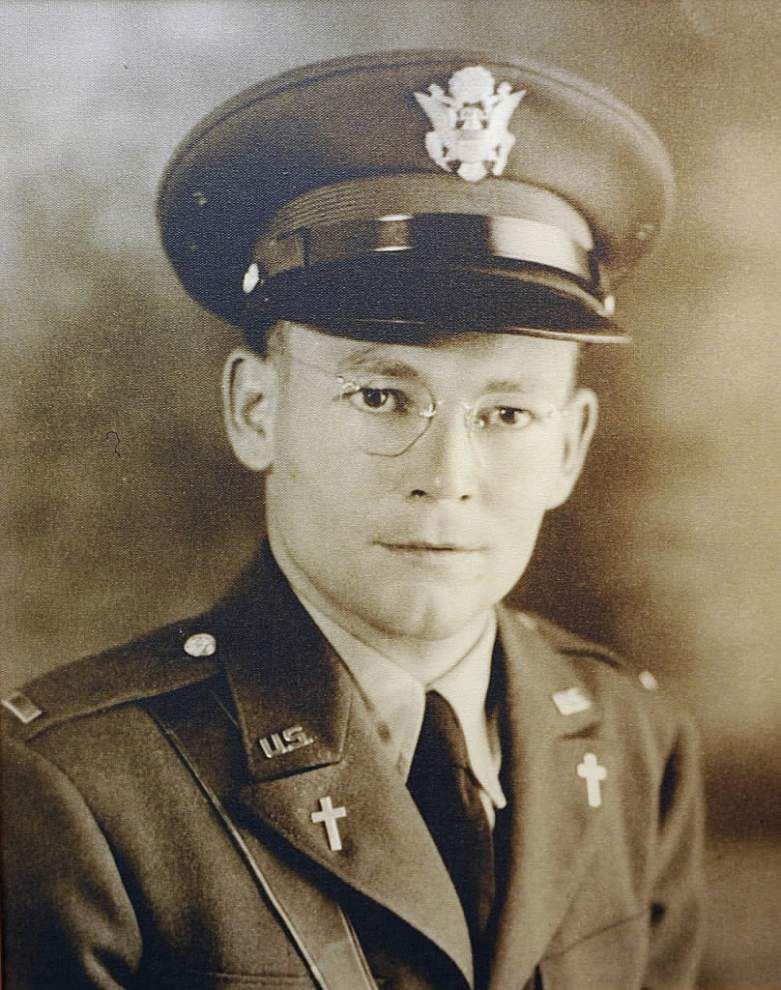
Father Lafleur: Forgotten Story of Chaplain to POWs in WWII and His 'Incredible Selflessness'
By: Our Sunday Visitor
The Diocese of Lafayette opened the cause for Father Joseph Verbis Lafleur’s canonization on September 5, 2020

(OSV News) — There was nothing elegant about St. Peter’s in Chains, the small chapel where Servant of God Father Joseph Verbis Lafleur celebrated Christmas Eve Mass on December 24, 1942.
It was a simple wooden hut, built in the middle of a Japanese prisoner of war camp, where Father Lafleur was being held prisoner.
Father Lafleur, ordained for the Diocese of Lafayette, Louisiana, on April 2, 1938, had enlisted as a military chaplain in early 1941 and was assigned to serve the U.S. Air Corps 19th Bombardment Group, stationed in the Philippines.
Two years later, he was captured by the Japanese during the early days of America’s involvement in World War II and was sent to a prisoner of war camp.
Eventually, Father Lafleur died when a U.S. submarine sank an unmarked Japanese prisoner of war transport, the SS Shinyo Maru, which was carrying U.S. prisoners of war to the mainland, killing all but 60 of the prisoners.
Recently, Michael Bell, executive director of the of the Jenny Craig Institute for the Study of War and Democracy at the National World War II Museum in New Orleans, began researching Father Lafleur’s life and service and presented his findings during a special reception on July 31.
“Father LaFleur is part of this unique experience of World War II, being stationed in the Philippines at the beginning of the war and then being sent to a prisoner of war camp and dying on a transport ship,” Bell told OSV News. “He also went to seminary here in New Orleans so he is this hometown hero. I pass that seminary, going to Mass on Sunday.”
On December 8, 1941, sirens blared across Clark Field in the Philippines, a U.S. military base. Simultaneously, on what was Dec. 7 due to the international date line, a Japanese aircraft carrier group had launched an air assault on the U.S. base at Pearl Harbor, Hawaii, marking the beginning of the United States’ involvement in World War II.
Father Lafleur, the base’s chaplain watched as Japanese planes dropped bombs and strafed the U.S. airfield. Seeing wounded soldiers, the chaplain jumped into action.
“Without regard for his personal safety, Father Lafleur is going from wounded soldier to soldier, providing comfort or helping evacuate him to safety and he really becomes an inspiration, not just for those he helped, but even for the leaders of that unit,” Bell said. “It starts to show this incredible selflessness when, you know, by all accounts, everybody else is taking cover and he is out there helping people.”
Father Lafleur’s example of selflessness continued when, after the attack, he was given the opportunity to evacuate to Australia. The chaplain, however, vowed to stay with his men, telling commanders that he will not leave until everybody else has been evacuated.
Thus, Father Lafleur retreated with the remaining soldiers to the Bataan Peninsula where they attempted to ward off the invading Japanese forces. However, their efforts stalled and on May 7th, 1942, Lafleur and the 19th bombardment group surrendered to the Japanese.
Yet the tale of Father Lafleur’s heroism had only just begun.
Father LaFleur was sent to Davao Penal Colony, a Japanese prisoner of war camp in the Philippines where he endured harsh living conditions and violent prison guards.
“The conditions get worse and worse over time,” Bell said. “Whatever food they had begins to dwindle and by mid-summer 1942, the Japanese become very violent. If American or Filipino prisoners escape or try to escape, they will do retribution against the other prisoners by punishing them or even executing some.”
Yet, Father Lafleur attempted to keep spirits high by providing the sacraments and being a listening ear to his fellow prisoners. Shortly after his arrival to Davao, Father Lafleur and other prisoners begin constructing a small wooden hut to serve as a chapel which they dub “St. Peter in Chains.”
There, they celebrated 1942 Christmas Eve Mass.
“One of the accounts suggests that as Father Lafleur is celebrating Mass, a couple of the other prisoners were so inspired that they pulled out an American flag they had been hiding and unfurled the flag and held it up, during this midnight Mass,” Bell said. “It becomes this huge inspiration for all of these prisoners to persevere.”
Shortly thereafter, the Japanese began selecting prisoners to be sent to Lasang, a nearby work camp. Lafleur, still recovering from a severe bout of malaria, volunteered to go, believing that to be where God was calling him to serve.
There, he remained until August, 1944.
With American forces rapidly closing in, the Japanese began sending American prisoners of war to camps on other Japanese controlled islands via “hell ships.”
Father Lafleur and 750 other Americans were loaded onto one of these hell ships, the SS Shinyo Maru, where they were stuffed into two cramped, below deck compartments with minimal ventilation, no toilets and barely enough room for each prisoner to sit down.
The men turn to Father Lafleur for spiritual guidance and encouragement as they suffer in the sweltering heat and complete darkness.
“One account that was shared with us recalls a soldier, who was suffering, finds Lafleur in the hold and asks, ‘Padre, can you please pray for me? Lafleur listens to him and tells him to say an act of contrition, and then almost simultaneously, the Japanese actually open the hatch,” Bell said. “Before that they are in this incredible heat, and now they have sunlight and a breeze.”
Tragically, on September 7, 1944, a US submarine fired upon the unmarked Japanese vessel.
“When the ship is hit, the Japanese began shooting at the Americans as they tried to come out of the hold and they began throwing grenades into the hold,” Bell said. “The account states that Father Lafleur was there, constantly trying to help people up and out, without regard to his own survival or safety.”
In the end, he helped 83 men escape but the transport ship snapped in half and sank to the bottom of the Pacific with Father Lafleur still onboard.
For years, Father Lafleur’s story remained largely forgotten, only to be recalled in official US reports, the testimony of his fellow prisoners, and within the Diocese of Lafayette, which opened his cause for canonization September 5, 2020.
After learning about Father Lafleur’s story, Bell knew that he wanted to know the full picture and share it with the world. He believes that Lafleur is an example of selflessness that can be a model for all.
“What is incredible with Father Lafleur’s story is that consistent selflessness,” Bell said. “It is a selflessness beyond being. It is this model of ultimate self-sacrifice that can be an example and model for all.”
– – –
Jack Figge writes for OSV News from Kansas.

